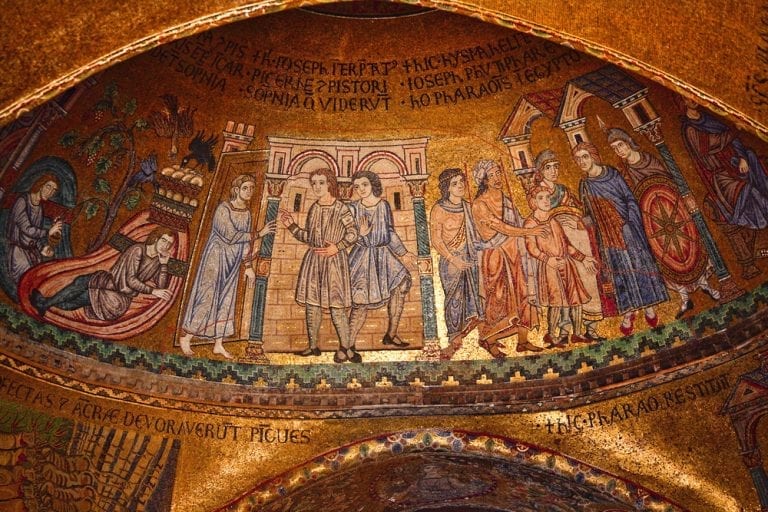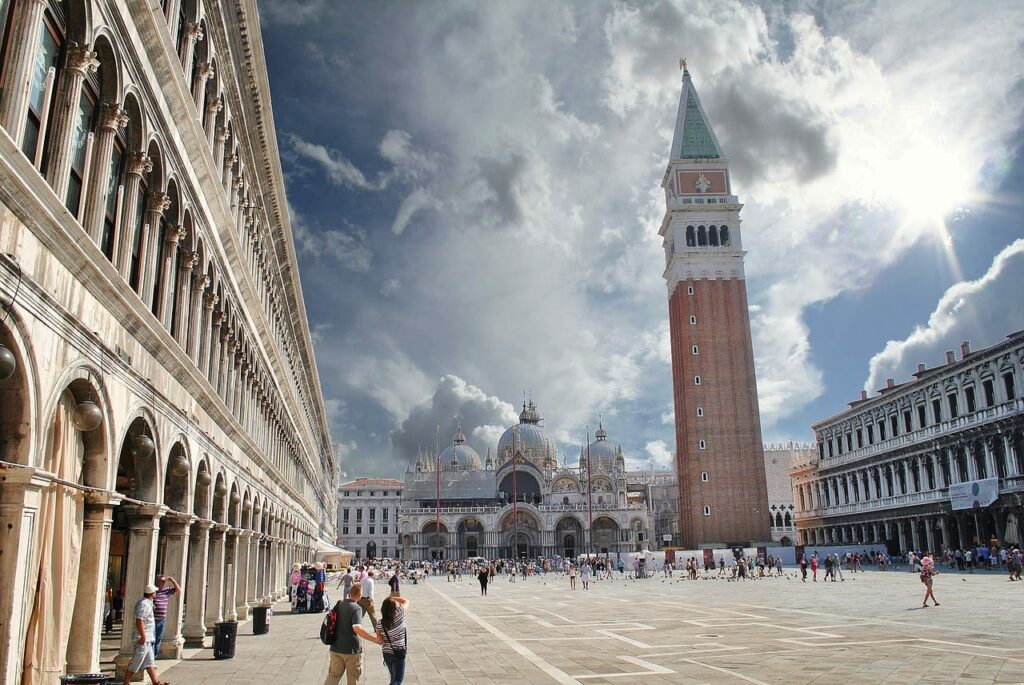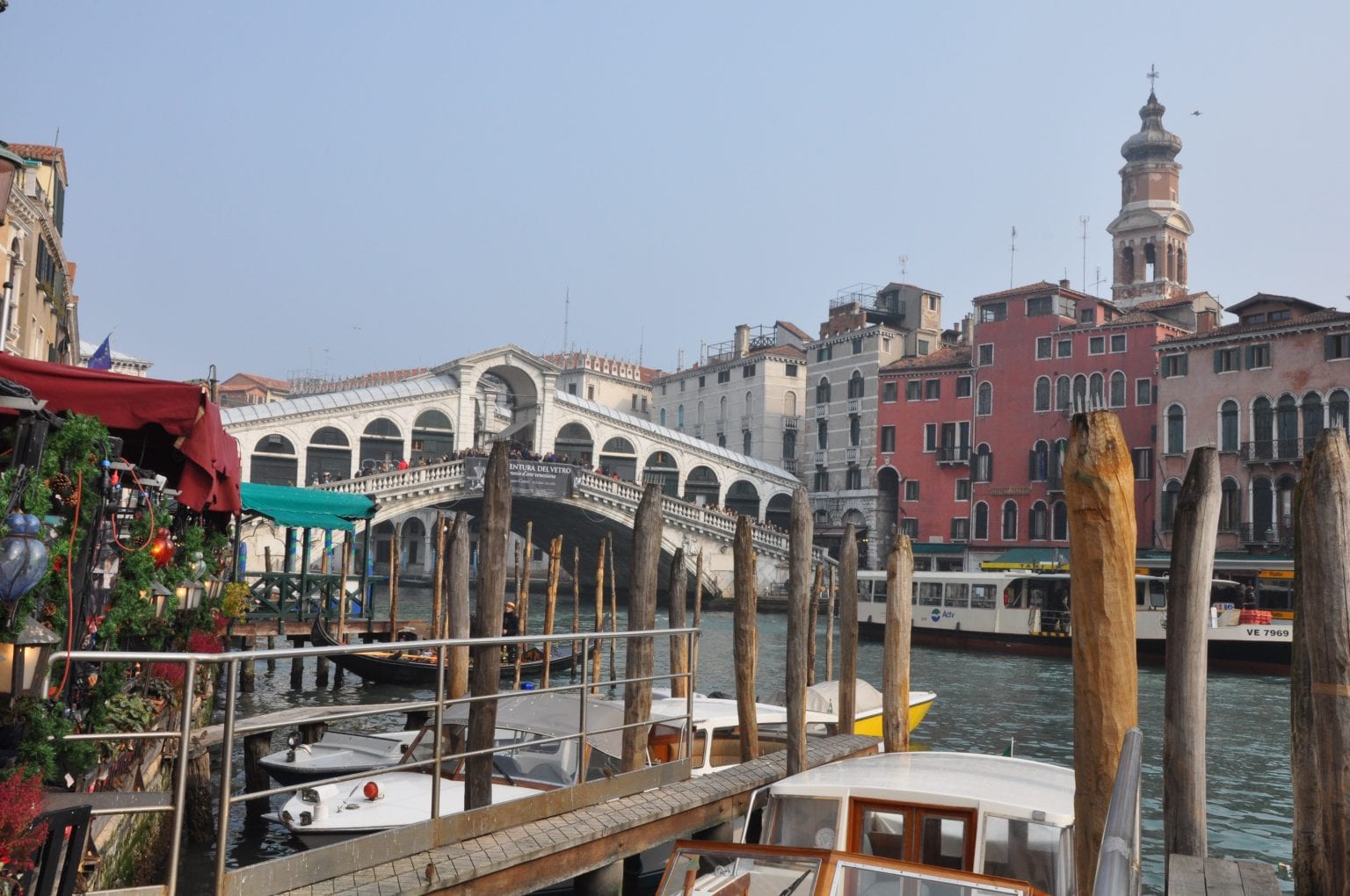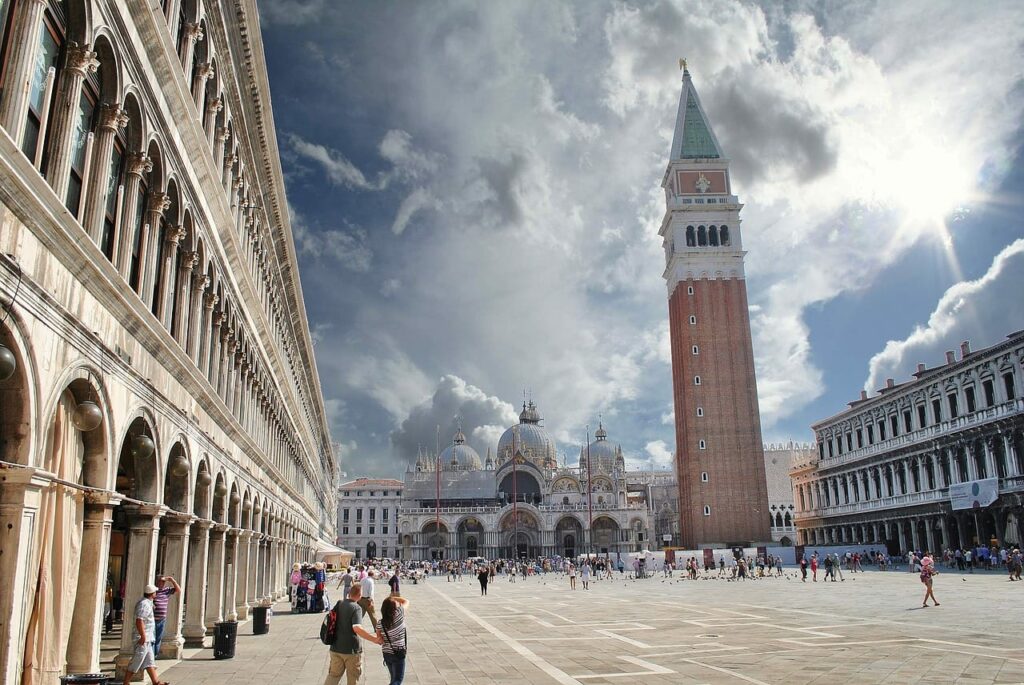探求しつづける
イタリア・ベネチア
エッセンシャルベニス
もっと見る
サン・マルコ寺院は、ベネチアで最も人気のある観光スポットの一つで、イタリア旅行の旅程には欠かせない場所です。しかし、その歴史は紀元9世紀にまで遡り、多くの興味深い物語や伝説を持つ教会でもあります。ここでは、サン・マルコ寺院の最も魅力的な事実を6つご紹介します
1バジリカは、誘拐という剣呑な物語から始まった
 第1回 サン・マルコ寺院 9世紀にこの場所に建てられた聖遺物館には、盗まれた聖遺物が納められていました。828年、ヴェネツィアの商人たちが、エジプトのアレクサンドリアから4人の使徒の一人である伝道者聖マルコの遺体を盗み出しました。伝説によると、彼らは樽に入れた豚肉の層の下に隠して、(イスラム教徒の)警備員の間をすり抜けたのだそうです
第1回 サン・マルコ寺院 9世紀にこの場所に建てられた聖遺物館には、盗まれた聖遺物が納められていました。828年、ヴェネツィアの商人たちが、エジプトのアレクサンドリアから4人の使徒の一人である伝道者聖マルコの遺体を盗み出しました。伝説によると、彼らは樽に入れた豚肉の層の下に隠して、(イスラム教徒の)警備員の間をすり抜けたのだそうです
航海中、嵐で墓参り客と大切な荷物が溺れそうになった時、聖マルコ自身が船長に現れ、帆を下げるように言ったと言われています。船は助かり、商人たちは「この奇跡のおかげで助かった」と言ったという。
バシリカに入って左側の扉の上にある13世紀のモザイク画に、その物語の全貌が描かれている。
2アメリカンフットボール場1.5面分のモザイクがあるそうです
There are more than 85,000 square feet (or 8,000 square meters) of mosaic in St. Mark’s Basilica… or enough mosaic to cover over 1.5 American football fields! The mosaics were done over 8 centuries, mostly in gold, and the result is astonishing. Enter the basilica at different times of day to see how the light makes the colors and scenes, look different.


3500以上のカラムがある
サン・マルコ寺院の大きさ、驚くべきものの 多さを示すもう一つの例は、柱の数です。バシリカには500本以上の柱と柱頭があり、そのほとんどが6世紀から11世紀のビザンチン様式のものです。中には3世紀の古典的な柱頭も混じっていますよ。

4バシリカの宝物の多くは十字軍とコンスタンチノープルからもたらされたもの
特に第4回十字軍は、サン・マルコ寺院に大金をもたらした。1204年、コンスタンティノープル(現在のイスタンブール)の征服で幕を閉じた十字軍である。
The result? A lot of treasure was shipped to Venice, and installed in St. Mark’s Basilica — including the four bronze horses, an icon of the Madonna Nicopeia, enamels of the Golden Altar-piece, relics, crosses, chalices, and patens!

5パラ・ドーロは王冠の宝石を凌駕する
ロンドン塔のきらびやかな宝石は忘れましょう。王室はサンマルコ寺院の比ではありません。ビザンチン様式の金製の祭壇幕であるパラ・ドーロには、文字通り何百もの宝石がちりばめられています。真珠1,300個、エメラルド300個、サファイア300個、ガーネット400個、アメジスト100個、さらにルビーとトパーズも含まれています。
6あの鐘楼?一度倒壊した

サン・マルコ寺院の高さ98.6mのカンパニエは9世紀に建てられたものだが、1903年に建て直されることになった。理由は?倒壊したのだ!16世紀に改修されたのですが、どうやらそれほどうまくはいっていなかったようです。
1902年7月14日に倒壊した。(それ以前にも何度か地震に見舞われていたのだが...)。バシリカのバルコニーは瓦礫に埋もれたが、幸いにも教会そのものは無事だった。しかし、この事件は恥ずかしい限りである。
1903年から1912年にかけて、鐘楼は、より安全な技術で、かつての姿に再建された。
6つほど紹介しましたが、せっかくなので、さらに魅力的な考察を紹介します。
- サン・マルコ寺院のモザイク画の金の部分は、本物の金を使っているんです
Venice was in the past a very wealthy city of merchants: what the Republic lacked in military strength or in land domination, it had in riches. The basilica’s mosaics are not just a way to please God and St. Mark or to communicate complex religious concepts, they were also a way to show the wealth of the city to important guests, like kings or ambassadors from other countries.
この金細工は実際に金でできており、薄い金箔を2層の透明なガラスで「挟んで」いる。このように貴重な素材を展示することで、ヴェネチア人は、その大きな献身と同時に、小さな国にとって極めて重要な政治的「重さ」を示すことができたのである。
- バシリカの上にある大きな外側のドームは、実はフェイクなのです
In Venice, it’s impossible to build huge structures: the terrain is frail, so you have to carefully stick to small, light and flexible buildings. But the Venetians had to find a way to astonish their guests: so they optimized some very clever tricks to cheat the eye and give everyone the impression that the buildings are huge and imposing.
In St. Mark’s Basilica, there is a great example of this: the five big domes that give the building its distinctive shape are just a superstructure made of wood covered with a thin layer of lead. They are actually completely empty: the brick-built domes with the mosaics that you see inside the church are much lower.
We can arguably say that the only role of those big empty domes is to make the building look much bigger than it really is: this way the ships approaching the city could recognize its shape from afar, and be even more astonished by the legendary city rising from the waters.
- 2019年、大きな「アクア・アルタ」が教会を完全に水没させた!
In the Venetian Lagoon, there are tides: sometimes these tides go higher than normal and as a result, some parts of the city get flooded. St. Mark’s Square is the lowest part of the city, so it’s pretty common to see its floor partially or totally submerged in water.
But on November 12, 2019, things went completely out of control: the tide rose so high that it reached the second-highest level ever recorded in the history of the city. The custodians of the church were unprepared for this event: the water not only flooded the antechamber of the basilica, which is at the same level as the square but also the church itself, which is much higher.
The damage was substantial and the building is still recovering: at least this tragic event gave a big push to the completion of the MOSE project, a system of mobile barriers meant to protect the Lagoon from the most dangerous tides. The barriers were tested a couple of times in 2020 and apparently, they worked fine: we all hope they will be able to protect the basilica in the future.
- サンマルコ寺院は最古のものでもなければ、ヴェネツィアで一番大きな教会でもないのです
The St. Mark’s Basilica was built starting from the IX century: but the history of Venice starts way before that moment, in the V-VI century. So there are churches around the city that predate the most important monument: according to historians, the oldest holy building of the city could be the church of San Giacometto, very close to the Rialto bridge. The Rialto area was, in fact, the first spot that was colonized when the islands started to be populated: the city of Venice was actually called “Rialto” for the first centuries.
Despite its enormous size, at least in proportion with the other buildings of the city, St. Mark’s Basilica is also not the biggest church: this title goes to the church of Santi Giovanni e Paolo, home to the very powerful Dominican monastic order. Their monastery was so big that when Napoleon conquered Venice he chose that building to become the first big public hospital in the city: and the hospital is there still today! You can learn more about San Giacometto and Santi Giovanni e Paolo if you take the Welcome to Venice tour or the Venice in a Day tour, which both feature these very important churches!

Special thanks go to our Walks of Italy guide Mosè Viero for sharing these additional interesting facts about St. Mark’s Basilica.
もっと詳しく知りたい方は サンマルコ寺院とドゥカーレ宮殿のヴェネチアでの体験談をご覧ください。また、本当に VIPな訪問をしたい方は、一般公開されていない時間帯にサンマルコ寺院にアクセスしてみてください
探求しつづける
イタリア・ベネチア
エッセンシャルベニス
もっと見る

